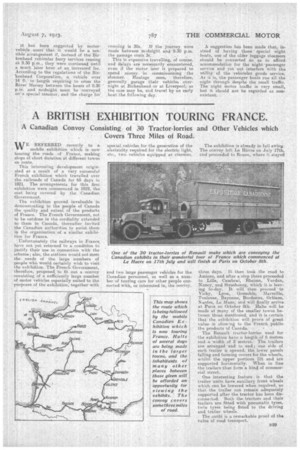HOW UNSUITABLE BRIDGES HOLD UP TRAFFIC.
Page 12

Page 13

If you've noticed an error in this article please click here to report it so we can fix it.
Some of the Advantages of. Motor Vehicles are Entirely Lost as the Direct Result of Traffic Congestion.
CONS1DEMNG the great number of vehicles, motor-propelled and horse-drawn, in service on the Liverpool Dock Estate—crossing perilously narrow bridges, negotiating congested blocks of traffic, and manteuvring into all sorts of difficult places—it is remarkable that such a continuity of transport service should be maintained with such freedom from mishap. When trade is booming, the pressure of traffic, " like the pent-up waters of a lake flowing through
the eye of a needle" (to use -Mark Rutherford's phrase), is increasing during the working hours of the day, and very frequently there are animated scenes at the bridge-heads to the various docks and to the cross-river ferries, Speedy self-propelled vans and wagons must then take their turn with the slowest-moving horse-drawn vehicle. For instance, when the tide is out, the bridges connecting the landing-stages of Liverpool, Birkenhead and Wallasey with terra firma are at a very acute angle, and if a heavily loaded horsedrawn lorry happen to be the first off the ferry boat, the motor vehicles on board the steamer wonld he in the rear until the top of the bridge was reached. These bridges have only two roadways— one for " up" traffic and the other for " down" traffic. This is not a satis factory arrangement for the • motor vehicle, the speed of which must be adjusted in such circumstances to that of the slowest-moving unit on the bridges.
Owing to trade depression, congestion at the Merseyside ferries is not so acute as it was two or three years ago, and on the Liverpool side the traffic for the Wallasey and Birkenhead boats respee• tively is regulated by the police, so that vehicles may be on the landing stage ready to embark upon the luggage -.steamer immediately space has been rendered available by the disembarkation of the vehicles due for Liverpool.
It has been suggested by motor. vehicle -users that it would be a sea: siblo'arrangement if, instead of the Birkenhead vehicular ferry services ceasing at 9.30 p.m., they were continued Until a much-later hour at an increased fee. According to the regulations of the Rix-. Itenhead. Corporation, a vehicle over 1411. in length requiring to cress the River Mersey betweeo the hours of 9.30 p.m. and midnight. inust be conveyed on -a special steamer, and the charge for
crossing is 30s. .If the journey. were made between midnight and 9.30 pm. the. passage costs. 3s..
This is expensive travelling, of course, and delays are necessarily encountered, even if the' Motor user is prepared to spend monev commissioning the steamer. Ifaulage men, therefore, generally garage their vehicles overnight at Birkenhead or at Liverpool, as the ease may be, and travel by an early boat the following day.
A suggestion has been made that, instead of having these special night boats,. one of the older luggage steamers should be converted so as to afford accommodation for the night. passenger service and yet not interfere with the utility of the vehicillar goods service. As it is, the passenger boats run all the night through despite the small traffic. The night motor traffic is very small, but it should not be regarded as non. existent.




























